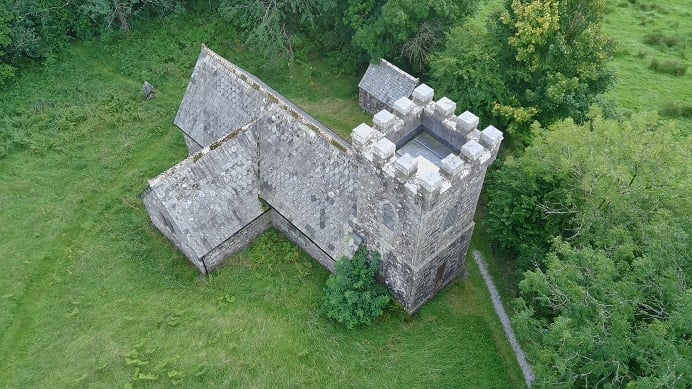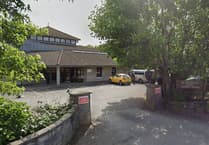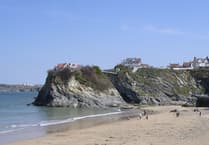Temple Church dedicated to St. Catherine of Alexandria is located on Bodmin Moor and quite isolated from any major settlements. It had until the late 19th century fallen into almost complete ruin for nearly 150 years. Travelling around Cornwall I quite often bump into someone I know.
My recent visit to Temple Church saw me unexpectedly finding the resting place of an old chap I remember from my days working in Bodmin as a teenager. I’m a friendly guy and like to have a chat, but in this case needless to say, the conversation was rather one-sided. Lovely and peaceful the sound of birds chirping was added to only by the soft whirring of my drone as it viewed the top of the church, with the somewhat overgrown churchyard providing a sanctuary for insects, small animal life and those wanting a place of tranquillity.
The parish of Temple lay in Triggshire one of the historic northern hundreds of Cornwall. It was only a small parish and in the early 19th century consisted of just eight tenements, land and buildings, with a population not exceeding 37 people. In Domesday, Temple was thought by 18th-century historians to have been included as part of the manor of Nietstone under Robert Count of Mortain, Earl of Cornwall, within the then larger hundred of Stratton. Sir John Maclean suggests it was to later become part of the manor of Trebihan.
The church at Temple was built about 1210 by the Knights Templar one of the crusader orders of that time. At this point I must digress, apologies to those who know the story of the Knight Templars and their demise, but many may not. Their origins were in France in 1119, with aims to protect pilgrims travelling to the Holy Land and over nearly two hundred years grew to be one of the most powerful and wealthy military orders. Receiving huge sums by way of inheritances they were a favoured, what we might term a charity, also developing trading interests and a banking business for transacting and lending money.
They constructed castles, fortifications and other buildings throughout the Holy Land and elsewhere including our small Cornish church named after them. Eventually their reason for existing failed as the Holy Land fell under Muslim control with the fall of Acre in 1291. King Philip the Fair of France was fortunate in the appointment of Clement V 1305 as Pope, who was very supportive of Philip. War with England led to a cashflow crisis for Philip who began to eye up the Templar wealth. Charged with heresy in 1307 many of the Templars in France, including the leaders, were arrested, tortured and burnt at the stake.
A curse was laid on the Pope and King in 1314 that they would die within a year, and against the Capetian royal house. The Pope died and the church he lay in burnt to the ground, Philip had a stroke whilst hunting, both dying within that year. The French royal house of Capet died out in 1328. Meanwhile Edward II of England jumped on the bandwagon and ended the Templars’ interests in England, our Cornish Temple Church was handed to another knightly order the Knights Hospitallers. Later in the 16th century, this time an English king ended that ownership, with Henry VIII’s dissolution of the monasteries during the Reformation.
Like its southerly neighbouring parish of Warleggan it was very isolated and following the Reformation became notorious as a church where illicit marriages would take place. Cornwall’s Gretna Green. The Clandestine Marriage Act of 1753 put a stop to that and for marriages to be legally binding, even for non-conformists and Catholics, they had to take place in a parish church or chapel of the Church of England and conducted by an ordained minister. It was from that point Temple Church began to fall into ruin as any potential congregation no longer attended the church. There are few accounts of what was taking place at St Catherine’s and sadly no records of any baptisms, marriages or burials survive, if any existed at all during this period.
It seems that many were recorded in those of Blisland parish. The bishops’ visitations of the 17th and 18th centuries mention the names of curates these are not particularly regular and whether any church services took place is unknown, certainly none from about 1780. Twelve acres of glebe land to provide additional income to support a parish priest were purchased in 1744, which included funds from Queen Ann’s Bounty of £200. This ensured that the church now came fully under the control of the Bishop of Exeter.
Although in ruins services began to be held occasionally at the church from 1880 when the Reverend Edward Steel, Vicar of St Neots was appointed. By that time an ash tree had grown in the ruins estimated to have been about 60 years old. When being removed the roots were seen to have broken into a vault beneath and wrapped around a skeleton, these were left in place. January 1882 saw the Rector of Helland the Reverend J R Brown take charge of the parish with regular services held at Temple.
Although the church was in ruins sufficient amounts of the granite walls and tower remained showing the original plans and remained firm. The Reverend Steel had begun to collect funds, and on taking over the Reverend Brown immediately opened discussions with the Bishop of Truro, Edward Benson, who was supportive of the reconstruction of Temple Church. The services of the esteemed Cornish architect Silvanus Trevail were obtained free of charge for drawing the plans. Trevail would afterwards complete many buildings including large hotels such as the Atlantic and Headland Hotels in Newquay and the Camelot Castle Hotel at Tintagel. Sadly his work carried out at this small rural church is often overlooked.
Temple Church stands on exactly the same footings as the original Templar church and as much of the original building, graves and monuments were retained. Many gifts to decorate and furnish the church were made by other parish priests. The original font was found and refurbished and stained-glass windows reflecting the church’s history installed. The original bell having been lost was replaced and on May Day 1883 once again the church bell was heard ringing across the parish. On Wednesday 30th May St Catherine’s Church at Temple was reconsecrated by the new Bishop of Truro, George Wilkinson. The former Bishop of Truro Edward Benson who had supported the rebuilding had been raised to Archbishop of Canterbury and installed the previous March. The parish of Temple merged with Blisland in 1934.
Over the centuries St Catherines has been visited by a number of writers who have voiced their varying opinions on this ancient site. The late 16th century topographer John Norden wrote at some length telling us ‘It is a place exempted from the bushops Jurisdiction, appertayninge in former times to the Templers: It is a lawless churche wher manie badd marriages are consummated. And here were they wonte to bury suche as wrowght violent death vpon themselves’
About two hundred and fifty years later in 1842, Cyrus Redding is really quite disparaging ‘Temple Moor; truly a waste howling wilderness, The parish of Temple is about six miles from Bodmin and gives name to a long tract of wretched downs between Bodmin and Launceston; it contains only three miserable huts and the remnant of a dilapidated church.’ Cornish historian Charles Henderson says of it in 1925 that all sorts of irregularities used to take place there and that ‘beyond its remoteness it is of little interest.’ Personally I think although it may not be architecturally impressive it is a wonderful little church with an interesting history set in a tranquil surroundings. Fortunately In 1951, Nikolaus Pevsner wrote the church is ‘of diminutive scale but strangely impressive in its remote moorland location’
Failure of the roof was once again an issue in 2015 when it was found that the nails holding the slates in place had corroded. Known as nail-sickness this necessitated replacement of the roof and the Diocese of Truro with the Blisland Parochial Church Council and supported with grants from various organisations and with wider community effort raised £100,000 to carry out the work.
Religion in Temple parish wasn’t all about the Templar Church, non-conformity with its many branches had arrived in Temple. The writings of Sir John Maclean tell us in 1875 that there was a Bible Christian non-conformist chapel recently built which could accommodate about 100 people located not far from the ruined church with eight members. This building like many former Methodist chapels was sold during the 21st century and converted into a residence in 2009.
On leaving the church we met a gent who on being greeted replied in an accent that identified him as Cornish, he then told me he was from Par and was just visiting for the first time. Nice to see some Cornish folk visiting out-of-the-way places in Cornwall. The visitors’ book showed the previous visitors had been from Germany. I’ve always found them to be great supporters of Cornish heritage.









Comments
This article has no comments yet. Be the first to leave a comment.